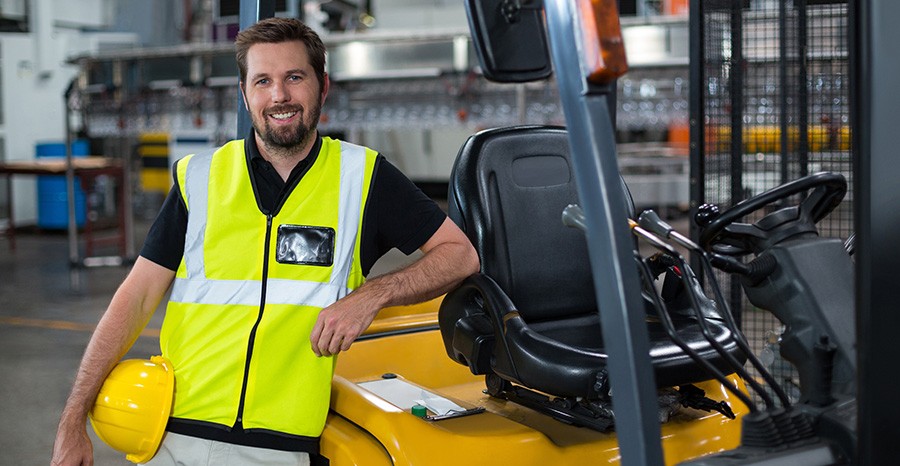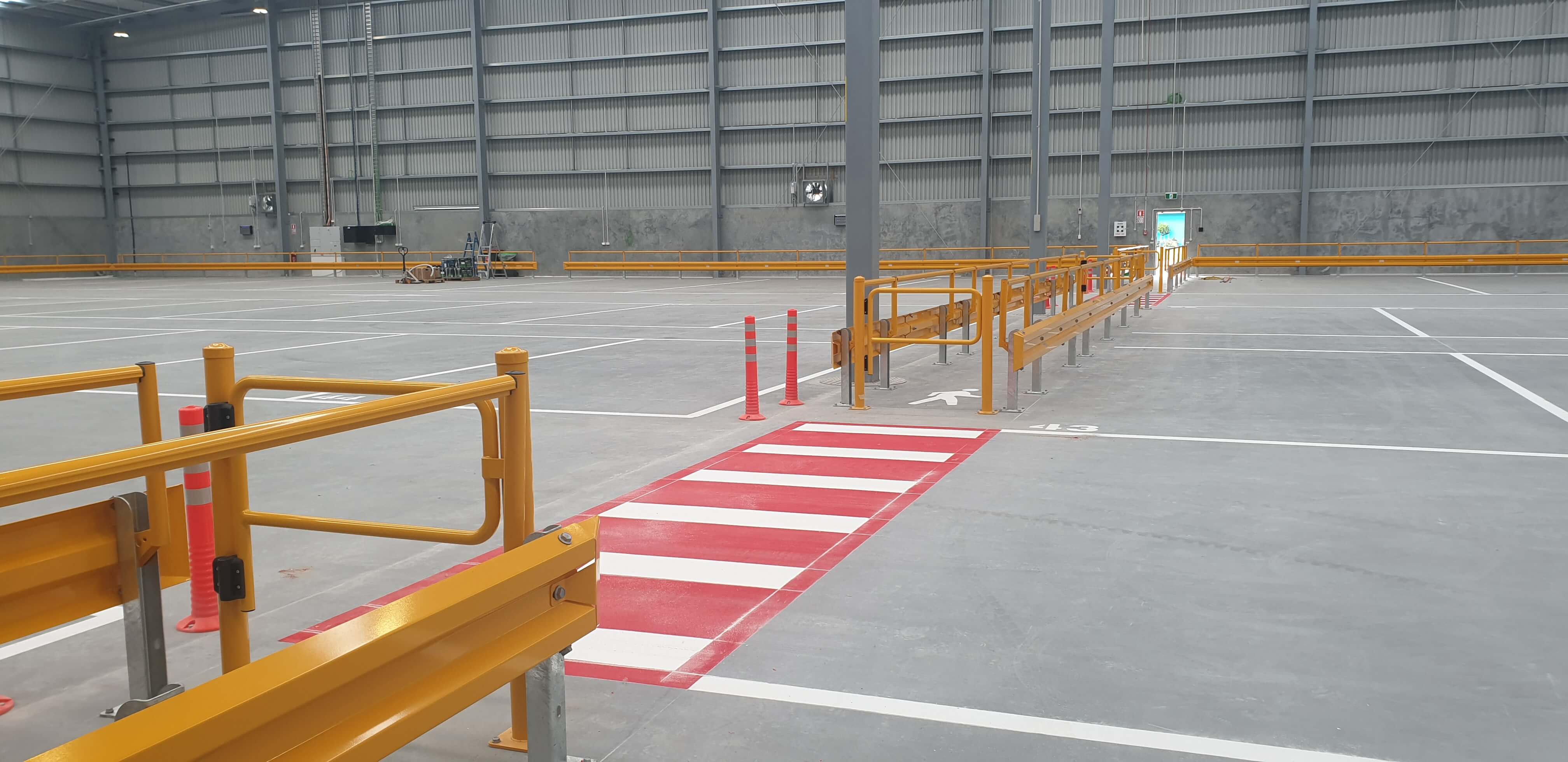Forklifts are a vital tool on worksites and in warehouses, as they allow the shuttling of inventory in an efficient and productive manner. However as the average forklift weighs between 1.8T-2.5T, and can travel at speeds up to 15kmph in New Zealand, it’s important that great care is taken. Forklift accidents cause harm to New Zealand workers every year and damage of products and assets.
Every workplace should be proactive in preventing forklift accidents by ensuring safe operating procedures are in place and educating employees on the protocols. In this blog, we’ve compiled a list of 10 ways to prevent forklift accidents to help you get started!
Follow a traffic management plan
The first step in preventing forklift accidents is to ensure that the company has a quality traffic management plan, which involves identifying possible hazards, assessing the possible risks and acting to control these by eliminating them or introducing safety measures.
As WorkSafe’s Simon Humphries said, “Forklifts are difficult to manoeuvre, they are frequently loaded to the point where visibility is compromised and they can be deadly when pedestrians are involved. Traffic management should be a paramount health and safety concern for businesses using them and for those with vehicles moving on, off and around your workplace”.
It’s important that all members of the team are aware of and involved in implementing these measures into their daily operations. While it is common for companies to have policies documented, accidents often occur when these are not put into practice and enforced by management.
Enforce warehouse speed limits
Excessive speed is one of the most common causes of forklift accidents, according to Worksafe. While a forklift can travel at at a speed up to 15km/h, drivers are encouraged to operate at safe speeds for the work they are carrying out. This means the responsibility is put on the company to define an appropriate speed limit based on the hazards in the specific working zone.
Therefore it’s important that each worksite applies maximum speed limits and ensures that all drivers are aware of these. Using speed limit signage throughout the warehouse can improve awareness of the imposed limits and serve as a reminder to staff, ensuring the rules are adhered to by all. Speed humps and speed cushions can also be installed throughout the facility to slow vehicles down.
Forklifts should always be operated at a speed that allows them to be stopped safely given the visibility and hazards. In open areas with minimum hazards, this is usually around 5 – 15 km/h, however, in congested areas or on slippery surfaces (for example, from excessive dust, water or oil spills), the speed should be reduced to under 5km/h. While a maximum speed might be defined in a working zone, the safe limit should always be considered as a variable depending on where the forklift is at the time, who is working within the same zone and what the forklift is carrying.
Ensure worksite is clean and organised
A clean and organised worksite provides a good starting point when implementing safe practices. Wet or uneven surfaces and sharp turns can cause stability issues in a forklift, due to the mechanical design of the vehicles. All staff should be encouraged to take responsibility for keeping the worksite safe from hazards, including cleaning up spills, removing obstructing items from pathways, keeping cables tidied away, disposing of packaging materials and clearing away equipment that’s not in use. When the forklift is not in use it should be left in a safe place in neutral with the handbrake on and the forks lowered to the floor with the tips on the floor.
Use forklifts that are well-maintained and safety-focused
Worksafe has confirmed that poor forklift maintenance is another one of the most common causes of incidents. It’s important that all drivers inspect their forklifts prior to use daily, including checking the tyre inflation, lifting mechanism and brakes, as well as for any leaks or external hazards.
When it comes to safety, not all forklifts are designed equally and the safety features on each forklift model have been consistently improving over time. These enhancements include tilt warning systems for uneven forks, motion sensored alarms, ergonomic seats with reinforced cage protection and improved stability sensors that automatically adjust the axle. As forklift accidents are one of the most prominent risks on site, companies should consider upgrading to a model with a higher safety rating to mitigate the risk of an incident or serious harm occurring.
Improve visibility
Warehouses and logistic centres are a busy hub of activity, with trucks regularly loading and unloading stock and an abundance of products being stored and picked. With many moving parts, there’s always different obstacles for drivers to factor in.
Maximising visibility is essential to ensure that drivers are aware of their surroundings. This can be achieved by ensuring that warehouses and yards are well lit, all employees are wearing high-visibility clothing and installing mirrors on any blind corners and areas of forklift operation that are hazardous.
According to Worksafe, another common cause of forklift incidents is drivers not looking in the direction of travel. Minimising other moving obstacles in the vicinity and enforcing exclusion zones will help ensure the driver can stay focused on where they are heading.
Separating pedestrians
One of the most effective ways to minimise forklift incidents within the warehouse is to ensure that those on foot are separated from moving vehicles. A combination of pedestrian training and good warehouse design is required to achieve this outcome. The facility layout should include well-defined vehicle routes, loading and unloading bays and clear pedestrian crossings.
Marking walkways with floor tape or paint and stencils is helpful in establishing clearly defined pedestrian safety areas and offer an affordable solution. However these lines can be disregarded easily by the walker, therefore using protective barriers and bollards is more effective at segregating areas and avoiding collisions. Our d-flexx barrier system is great for this as they are flexible, shock-absorbent and highly impact-resistant impact without damaging the floor, vehicle or the barrier itself.
It’s also important to ensure that truck drivers within the warehouse or yard either remain in their cab or are escorted to a safe zone to wait while their load is being moved by a forklift. Visitors to the site, including truck drivers, should be inducted into the workplace to ensure that they are aware of the safety procedures in place and high-viz clothing should be used at all times. When forklifts are re-stocking shelves, it is good practice to temporarily restrict access to the aisle.
Seatbelts should be worn at all times
Similar to the use of other vehicles, seatbelts should be worn at all times to minimise the risk of harm in the case of an incident. Due to the instability of some forklifts and loads, paired with less surface friction than other vehicles, forklifts can be prone to tipping or rolling over. The reinforced cage is designed to protect the driver in these situations, however, the seat belt must be in use for this to work.
Forklift drivers are trained and skilled
In New Zealand, all those operating a forklift need to be trained and qualified to do so. According to Toyota, 25% of all forklift accidents are a result of inadequate training, therefore it’s important that this training is ongoing and tailored to each work environment to suit individual needs. There also needs to be serious disciplinary repercussions for anyone demonstrating unsafe behaviour, such as letting others ride on the forklift prongs (which has been identified as a common cause of harm).
Worksafe has produced a Code of Practice for instructors of powered industrial lift trucks (forklifts) and trainers to use. This provides a comprehensive understanding of the safety standards, rules, procedures and codes applicable, as well as practical knowledge of how the vehicle operates and loads are managed.
Maintain safe loading practices
All forklift drivers should have a good understanding of best practices when loading, carrying and unloading with the equipment. These include ensuring that:
- Loads are always within the forklift’s rated weight capacity.
- Manufacturers stacking instructions are followed carefully to avoid unbalanced loads.
- The overall stacked height does not diminish visibility.
- Loads are tilted back before raising or driving.
- Drivers are being vigilant of any damaged, unstable or slipping loads when handling.
- Pedestrians never walk under a raised load.
Minimise reversing
To mitigate the risk of crashing into structures, other vehicles or pedestrians, reversing for long stretches in a forklift should be eliminated where possible. This can be achieved in some areas of the warehouse by implementing a one-way drive-through layout. Where this is not possible, extreme care should be taken when reversing, including checking blind spots, excluding unnecessary staff from the area and ensuring others (including spotters) are wearing high-visibility clothing.
Using reversing cameras, beepers and sensors can also help with improving awareness of the surroundings. Corner protection and energy absorbing bollards can be used to reduce harm and the potential repair costs for any incidents that do occur. These minimise damage from knocks and shocks in the case of a forklift collision.
Using a forklift presents a number of hazards, however, a good traffic management plan can help you mitigate the risk of these accidents. A holistic approach needs to be taken to forklift safety, from training for both drivers and pedestrians to physical products that improve safety, such as barriers, speed cushions and mirrors.
For more information about improving safety within your warehouse, check out our Warehouse Safety Tips blog. If you would like to assess the risks within your own warehouse, please complete our Warehouse Safety Checklist.
Alternatively, if you would prefer to discuss safety solutions directly with one of our experienced staff members, please contact us on the form below and we’ll respond within 60 minutes.

.jpg)
.jpg)

.jpg)